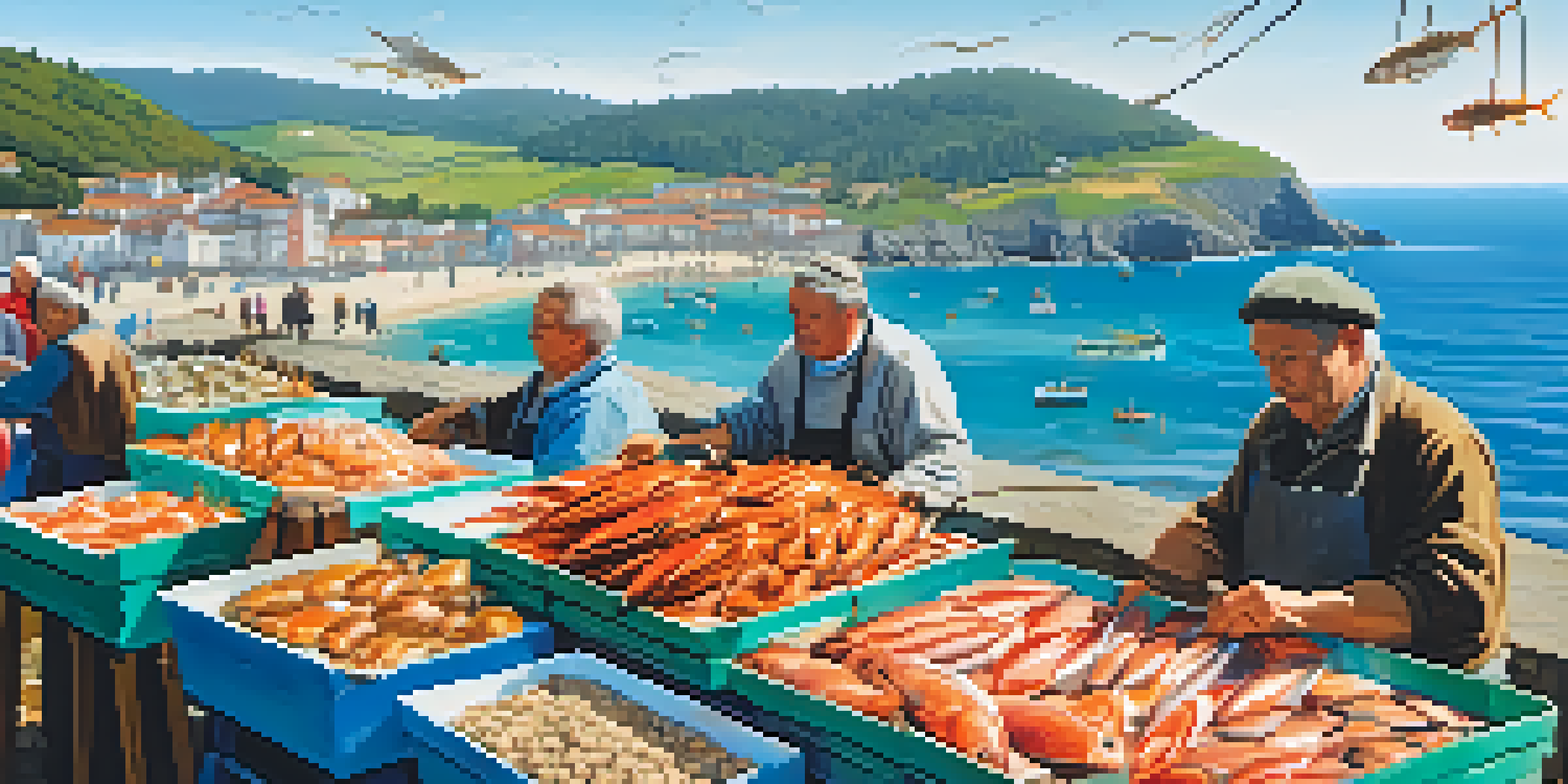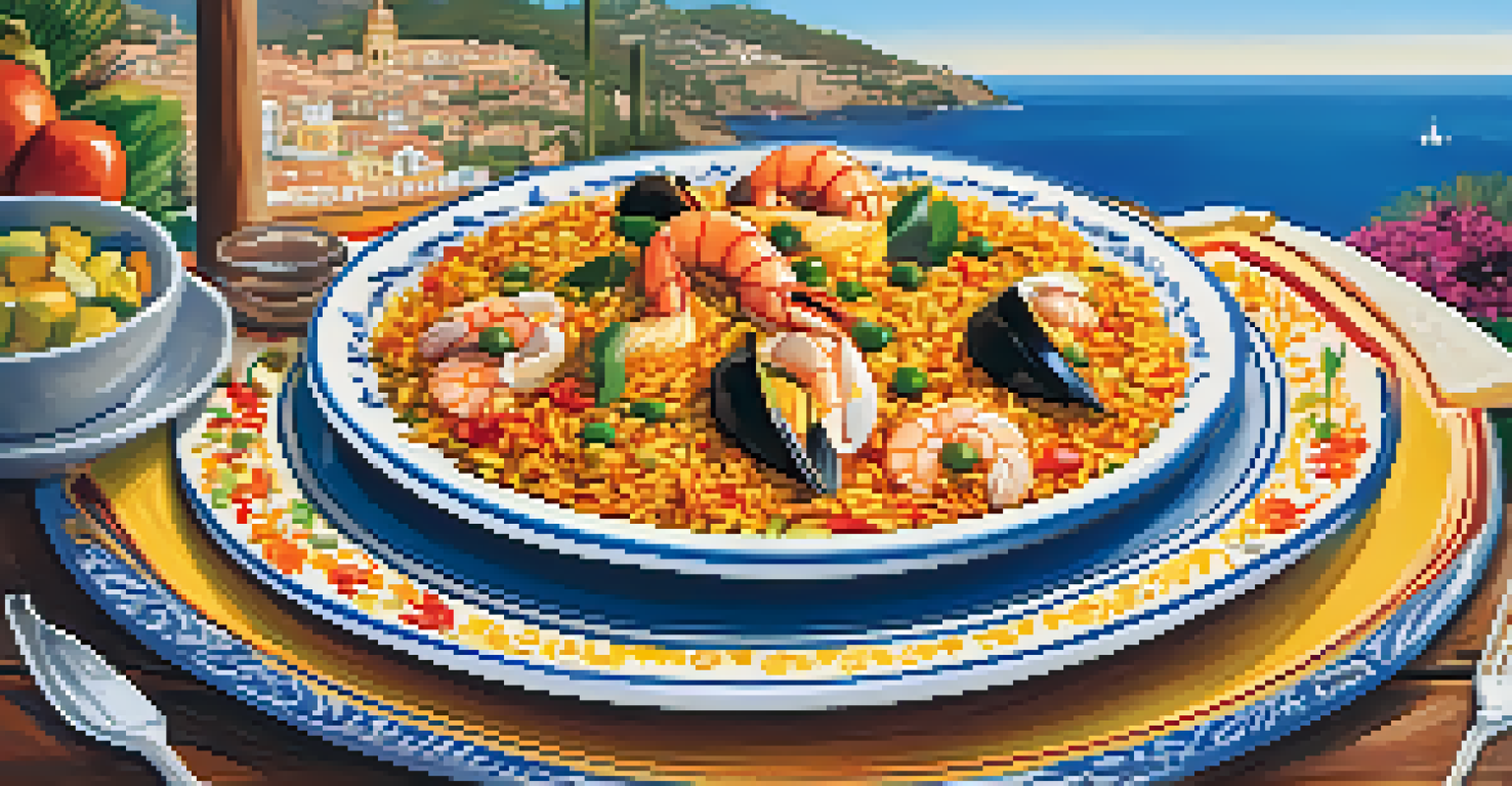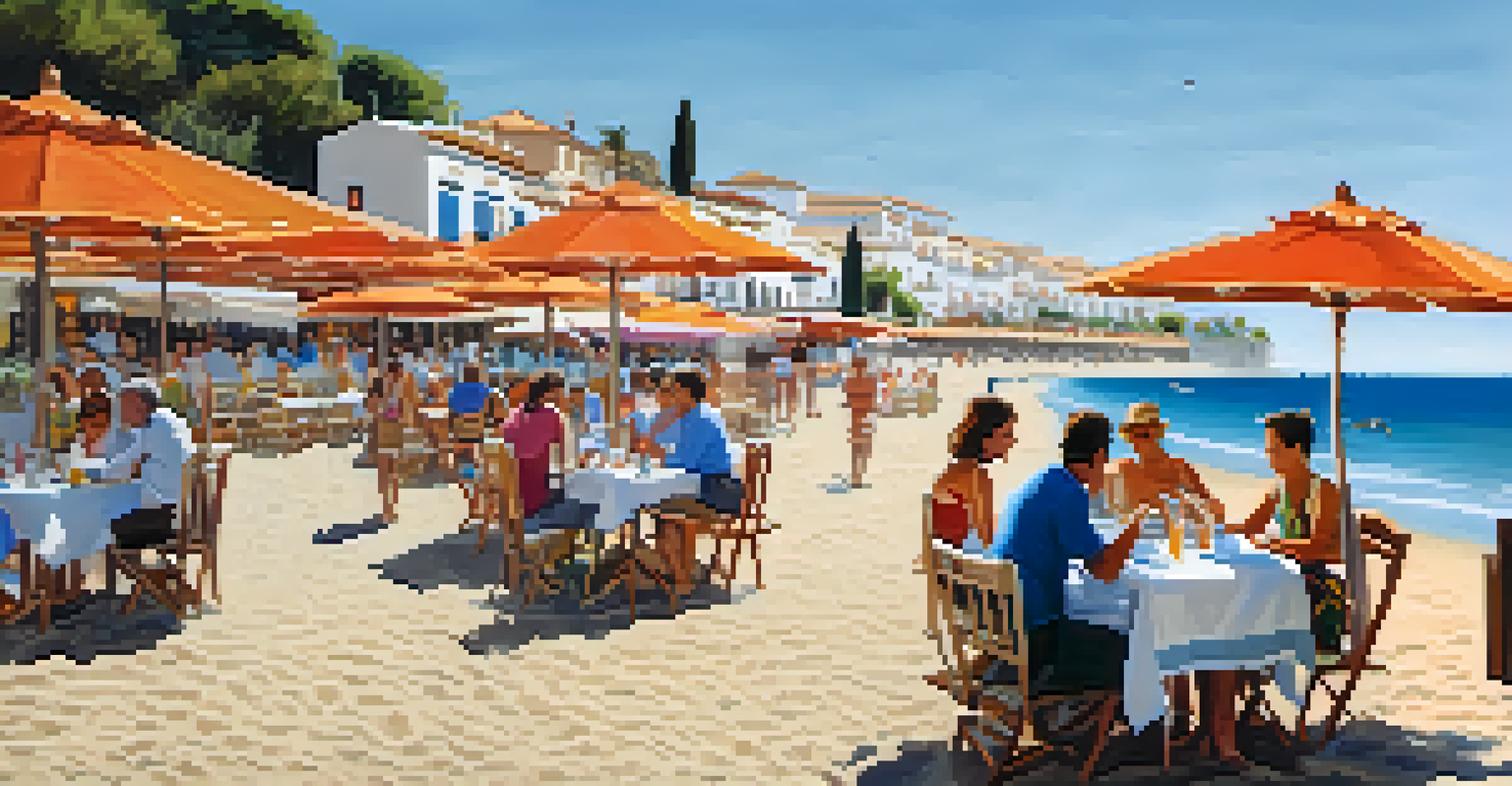Culinary Traditions of Spain's Coastal Regions: A Maritime Feast

Introduction to Spain's Diverse Coastal Cuisine
Spain's coastal regions are a culinary paradise, blending fresh ingredients with rich cultural traditions. From the rugged cliffs of Galicia to the sun-kissed beaches of Andalusia, each area offers unique flavors shaped by its geography and history. The proximity to the ocean means that seafood plays a starring role in many dishes, showcasing the bounty of the Mediterranean and Atlantic.
Food is a central part of the human experience, nourishing not just the body but also the soul and the community.
Understanding these culinary practices requires a journey through Spain's diverse landscapes, where local fishermen bring in the day's catch, and markets brim with vibrant produce. This connection to the sea not only influences the ingredients but also the cooking techniques and traditions passed down through generations. Each dish tells a story, reflecting the people and their relationship with their environment.
As we delve deeper into the coastal culinary traditions, we'll uncover the regional specialties, cooking methods, and cultural practices that make Spain's maritime feast truly unique. Get ready to tantalize your taste buds with a gastronomic adventure along Spain's shores.
Galicia: The Land of Seafood and Rich Flavors
Galicia, in the northwest corner of Spain, is renowned for its exceptional seafood, thanks to its rugged coastline and clean waters. Dishes like 'pulpo a la gallega' (Galician-style octopus) and 'mariscada' (seafood platter) highlight the region's bounty, often served with a drizzle of olive oil and a sprinkle of paprika. The emphasis on fresh ingredients makes every bite a celebration of the sea.

The region's unique climate and geography allow for the cultivation of exquisite shellfish, such as percebes (goose barnacles) and clams, which are often enjoyed with minimal seasoning to let their natural flavors shine. Fishermen in Galicia respect age-old traditions, and many families have been in the fishing business for generations, ensuring that the skills and knowledge are passed down.
Spain's Coastal Culinary Diversity
Spain's coastal regions offer a rich variety of seafood dishes influenced by local geography and cultural traditions.
Galician cuisine is not just about seafood; it also embraces hearty dishes like 'empanada' (savory pie) and 'caldo gallego' (Galician broth), which warm the soul. This blend of rich flavors and fresh seafood reflects the region's vibrant culture and the deep connection its people have with the land and sea.
Catalonia: A Fusion of Land and Sea
Catalonia is a culinary melting pot where the Mediterranean meets the Pyrenees. This diverse region offers a rich tapestry of flavors, from grilled fish to hearty stews that incorporate both sea and land ingredients. One standout dish is 'suquet de peix,' a traditional fish stew that combines various types of seafood with potatoes and a flavorful broth, showcasing the best of Catalonia's coastal offerings.
Eating is a necessity, but cooking is an art.
In addition to seafood, Catalonia is famous for its use of fresh vegetables and herbs, which are often featured in dishes like 'escalivada' (roasted vegetables) and 'pa amb tomàquet' (bread with tomato). The emphasis on local and seasonal produce enhances the culinary experience, allowing flavors to shine in their simplest forms. This farm-to-table approach connects diners to the region's agricultural heritage.
Catalonia's culinary traditions are also celebrated through its vibrant markets, where locals shop for the freshest ingredients. The bustling atmosphere of these markets reflects the region's appreciation for quality food and craftsmanship, making dining in Catalonia an experience that resonates with both locals and visitors alike.
Andalusia: A Celebration of Spices and Flavors
Andalusia, the southernmost region of Spain, is known for its vibrant flavors and aromatic spices, often influenced by a blend of cultures. Dishes like 'pescaíto frito' (fried fish) exemplify the region's love for seafood, featuring small fish lightly battered and fried to perfection. This simple yet delicious dish can be found in beachside chiringuitos (beach bars) that line the coastline, offering a relaxed dining experience with fresh ocean views.
The use of spices is a hallmark of Andalusian cuisine, often drawing from its Moorish history. Ingredients like saffron and cumin add depth to dishes such as 'paella' and 'caldo andaluz' (Andalusian gazpacho), highlighting the region's rich culinary heritage. Each bite reveals layers of flavor, showcasing a harmonious blend of tradition and innovation.
Regional Specialties Shine Through
Each region, from Galicia to Valencia, boasts unique culinary specialties that highlight fresh, local ingredients and age-old cooking techniques.
Andalusia's culinary scene is also marked by the tradition of tapas, small plates that encourage sharing and socializing. This communal style of dining is a celebration of community, allowing diners to sample a variety of dishes, from seafood to cured meats, while enjoying the warm, sunny climate of the region.
Valencia: The Birthplace of Paella
Valencia, located on the eastern coast of Spain, is often celebrated as the birthplace of paella, one of Spain's most iconic dishes. Traditional Valencian paella is made with rice, saffron, and a mix of fresh seafood and meats, creating a colorful and hearty meal that reflects the region's agricultural and maritime heritage. It's a dish best enjoyed outdoors, where the aromas can mingle with the sea breeze.
The region's fertile plains contribute to its culinary reputation, with a wealth of fresh vegetables like tomatoes, green beans, and artichokes playing a crucial role in many recipes. Valencia's local markets are a feast for the senses, filled with vibrant produce and artisanal goods, inviting culinary enthusiasts to explore and create.
In addition to paella, Valencia boasts a variety of other seafood dishes, such as 'fideuà,' a noodle-based dish similar to paella but made with thin noodles instead of rice. This showcases the region's adaptability and creativity, as chefs continue to innovate while honoring traditional flavors.
The Balearic Islands: A Taste of Island Life
The Balearic Islands, known for their stunning beaches and vibrant culture, also offer a unique culinary experience that reflects their maritime heritage. Dishes like 'sobrasada,' a cured sausage, and 'ensaimada,' a sweet pastry, highlight the island's distinctive flavors, but it's the seafood that truly shines. Fresh fish, octopus, and shellfish are staples, often grilled or served in traditional stews.
Local fishermen play a vital role in the islands' culinary landscape, ensuring that the freshest catch makes its way to the dining table. Many restaurants embrace the farm-to-table philosophy, sourcing ingredients from local producers and emphasizing seasonal offerings. This commitment to quality enhances the dining experience, allowing visitors to savor the true essence of the islands.
Culinary Festivals Celebrate Heritage
Numerous food festivals across Spain's coasts not only honor traditional dishes but also foster community pride and tourism.
Dining in the Balearic Islands is not just about the food; it's also about the experience. Many meals are enjoyed al fresco, with breathtaking views of the Mediterranean and a lively atmosphere that invites relaxation and connection with friends and family. The islands' culinary traditions are a celebration of life by the sea.
Culinary Festivals: Celebrating Coastal Delicacies
Spain's coastal regions are home to numerous culinary festivals that celebrate local seafood and traditional dishes. Events like the 'Feria del Marisco' in Galicia showcase a variety of seafood dishes, from octopus to shellfish, allowing visitors to indulge in the best of the region's flavors while enjoying live music and cultural performances. These festivals create a festive atmosphere that highlights the community's pride in their culinary heritage.
In Valencia, the annual 'Paella Festival' brings together chefs from around the world to compete in creating the best paella, attracting food lovers eager to sample different variations of this iconic dish. Such events foster camaraderie and creativity, as chefs share tips and techniques while celebrating their love for local cuisine.

These culinary celebrations not only honor the region's rich culinary traditions but also promote tourism and local businesses. Attending a food festival is a fantastic way to immerse oneself in the culture, meet locals, and experience the vibrant flavors that define Spain's coastal regions.
Conclusion: A Culinary Journey Worth Exploring
Exploring the culinary traditions of Spain's coastal regions is a feast for the senses that captivates both locals and visitors alike. Each region offers a unique perspective on seafood cuisine, influenced by its geography, culture, and history. From the hearty seafood platters of Galicia to the vibrant paellas of Valencia, every dish tells a story that connects us to the land and sea.
As we’ve seen, the culinary practices in these regions are not just about food; they reflect the people and their way of life. The emphasis on fresh, local ingredients and time-honored traditions creates a rich tapestry of flavors that invites exploration and appreciation. Whether you're savoring a plate of tapas in Andalusia or enjoying a bowl of 'caldo gallego' in Galicia, each bite offers a glimpse into the heart of Spanish coastal culture.
So, whether you're planning a culinary trip to Spain or simply looking to recreate these dishes at home, remember that the essence of these coastal traditions lies in their connection to the sea and the community. Dive into this maritime feast and let your taste buds embark on an unforgettable journey through Spain's coastal regions.